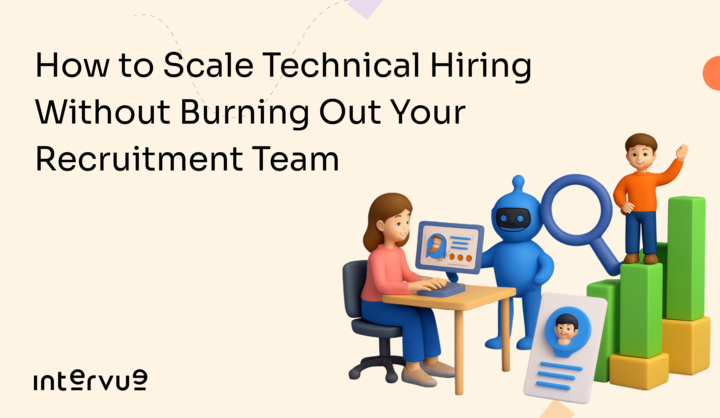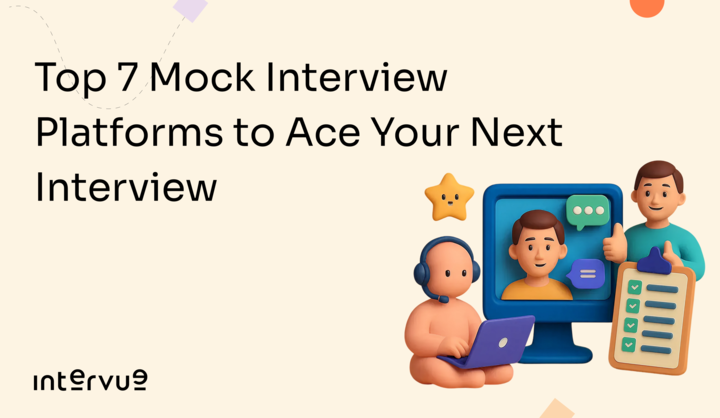How to Scale Technical Hiring Without Burning Out Your Recruitment Team
Intervue gives growing companies a way to scale interviews without scaling burnout. By offering structured live coding environments, role-specific rubrics, and external interviewers on demand, it removes the biggest friction point in hiring, internal bandwidth.

If there’s one thing every growing tech company learns the hard way, it’s this: scaling technical hiring feels less like growth and more like chaos in disguise. One week, you’re trying to find a single backend engineer. Next, you’re staring at a spreadsheet with twenty open roles, six hiring managers pinging you for updates, and an inbox overflowing with “quick candidate checks.”
You start strong, scheduling back-to-back interviews, chasing feedback, juggling calendars, but by week three, the energy drops. Recruiters start sounding tired. Hiring managers get impatient. Candidates slip away. And that’s when you realize: the hardest part of scaling isn’t the hiring itself, it’s keeping your team sane while doing it.
Why scaling tech hiring is uniquely painful
Recruiting engineers is a different beast. You’re not just matching keywords on resumes; you’re decoding portfolios, GitHub repos, side projects, and trying to read between lines of code. The stakes are higher, the cycles longer, and the supply smaller.
A 2024 survey by Stack Overflow found that more than 60% of software developers weren’t actively looking for a job, even though many were open to offers. That means your recruiters are fishing in a pond where most of the fish aren’t even biting. Add to that the pressure to move fast, and you’ve got a recipe for burnout.
And burnout in recruiting isn’t theoretical. According to research from Testlify, over half of recruiters globally reported feeling more stressed in 2023 than the year before. It shows up quietly, a delayed feedback loop here, a missed follow-up there until suddenly, your best recruiter is handing in their notice.
Scaling technical hiring successfully, then, isn’t just about hiring more engineers. It’s about designing a system that can expand without breaking the people running it.
Start by slowing down
The irony of scaling is that the first thing you should do is stop rushing. Most companies get into trouble because they try to scale before their process is ready to handle it.
Before you even think about posting another job, document what’s working and what’s not in your current hiring process. How long does it take to move a candidate from application to offer? Where do most drop-offs happen? How long does feedback take?
When you visualize the entire journey, the problem areas become obvious. Maybe it’s the week-long gap between interviews. Maybe your recruiters spend half their time chasing interview feedback. Or maybe your hiring managers aren’t calibrated on what “good” looks like.
Fixing these cracks before you scale is the difference between compounding success and compounding chaos.
Clarity over chaos
Recruiting teams burn out when ambiguity becomes the norm. When nobody knows who owns what, every step turns into a mini firefight.
To avoid that, create absolute clarity in your hiring journey. Define who decides what, who communicates with whom, and how success is measured. It doesn’t have to be a hundred-page playbook, just something simple enough that a new recruiter could pick it up and run with it.
Then comes calibration. Engineers and recruiters often speak different dialects of the same language. One might say “strong in systems,” while the other thinks “knows distributed caching.” Get them in the same room. Review real candidate examples. Debate, disagree, and align.
When everyone agrees on what “great” looks like, you save your team hundreds of hours later.
Technology is a multiplier, not a miracle
Let’s talk about tools, the love-hate relationship of every TA leader. The truth is, technology can make your recruiters superheroes, but it can also bury them under dashboards.
What actually works is simple automation. Scheduling tools that sync automatically with calendars. Interview intelligence software that records and transcribes conversations so feedback isn’t lost in memory. Automated nudges that remind interviewers to submit scores.
A 2025 Forbes Tech Council report summed it up perfectly: scaling hiring successfully has less to do with adding people and more to do with adding leverage. Technology should make every recruiter twice as effective, not twice as busy.
But the key is integration. The moment your ATS doesn’t talk to your scheduling software, or your coding test results don’t flow back into candidate profiles, you’ve created double work. And double work is burnout disguised as progress.
Borrow help when you need it
One of the most dangerous myths in recruitment is that every role must be filled in-house. When hiring surges hit, flexibility is your best friend.
You don’t need to double your headcount permanently; you need elastic capacity. Bring in contract recruiters during peak seasons. Partner with external interview platforms (like Intervue) to handle technical assessments when your internal engineers are at capacity. Or use interview-as-a-service models that take the load off your team without compromising quality.
This hybrid model is how fast-growing startups like Razorpay and M2P managed to scale hiring without losing their internal teams to exhaustion. The internal recruiters focused on what they do best, building relationships, nurturing candidates, and managing offers, while external partners handled repetitive interview cycles.
It’s a simple equation: let your team focus on humans, not logistics.
Scale in waves, not explosions
Here’s a mistake many companies make: they try to hire fifty engineers in one quarter as if speed alone wins the game. But scaling is not about going faster; it’s about staying consistent under pressure.
Think of it like interval training. You push hard, recover, then push again. Start with one department or function, say, backend engineering. Run the process end-to-end. Measure what breaks. Fix it. Then expand to the next.
This staggered growth lets you refine your process as you go. It also gives your recruitment team room to breathe between surges. Each wave becomes a feedback loop that improves the next one.
A Gartner report on scalable recruiting functions put it well: growth-stage companies should scale hiring “like an accordion,” able to expand and contract depending on business needs, without losing rhythm.
Measure what matters (and nothing else)
Recruitment loves dashboards, but not everything that glows is gold. Measuring too much is as harmful as measuring nothing.
Focus on the few signals that actually reflect team health. Time-to-hire will tell you if your process is efficient. The offer acceptance rate will tell you if candidates trust your process. Recruiter workload, the number of open roles per recruiter, will tell you if burnout is around the corner.
But here’s the underrated one: recruiter sentiment. Run short, anonymous pulse checks every month. Ask one simple question: “How sustainable does your current workload feel on a scale of 1–10?” When that average dips below 7, you know trouble is brewing.
Scaling sustainably isn’t about hitting hiring goals at all costs. It’s about protecting the people who get you there.
Protect the humans behind the process
Here’s something most founders and CHROs forget: recruitment is emotional labor. It’s hundreds of micro-interactions selling, listening, comforting, persuading, often in the face of rejection.
Your recruiters aren’t robots. They’re storytellers, negotiators, and brand ambassadors rolled into one. When they’re tired, your brand sounds tired.
Give them recovery time. Rotate them out of repetitive roles. Celebrate wins, even small ones. Make mental health part of your TA strategy, not an afterthought. A recruiter who feels valued will out-hustle ten who feel used.
Radancy’s 2024 study on recruiter burnout found that teams who implemented structured rest cycles, even just one slow hiring week per quarter, saw a 35% improvement in output quality and a significant drop in attrition.
The math is clear: rest scales better than overtime.
The Intervue advantage
If scaling technical hiring is starting to sound like a balancing act, that’s because it is. And that’s exactly the problem platforms like Intervue were built to solve.
Intervue gives growing companies a way to scale interviews without scaling burnout. By offering structured live coding environments, role-specific rubrics, and external interviewers on demand, it removes the biggest friction point in hiring, internal bandwidth.
Instead of overloading your engineers and recruiters, Intervue acts as an extension of your team. You get consistent evaluations, data-backed assessments, and detailed reports, all while your internal team stays focused on strategy and candidate experience.
It’s how companies like Nykaa, British Petroleum, and NPCI manage to scale hiring across geographies without turning their TA teams into crisis managers.
Scaling smart is the new scaling fast
There’s a quiet shift happening in tech hiring. Companies that used to celebrate speed are now celebrating sustainability. The question isn’t “how fast can we hire?” anymore, it’s “how long can we keep doing this without breaking our people?”
The future belongs to the teams that find balance. The ones that build clarity before chaos. The ones that use technology to empower, not exhaust. The ones that treat recruiters as the heartbeat of hiring, not its background noise.
Because scaling isn’t just about adding headcount. It’s about building an engine that runs smoothly even when the world speeds up.
And if you design that engine right, you’ll not only scale your technical hiring you’ll keep your team energized enough to enjoy the ride.



